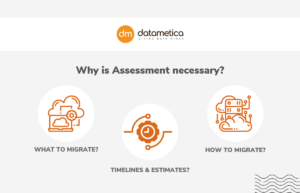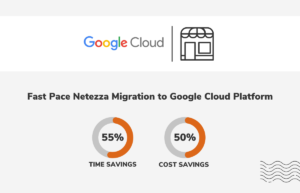Most of the organizations have cloud migration as the topmost priority in their IT transformation checklist. There might be different reasons supporting cloud migration, of which some of the top reasons are – cost management, innovations (new analytics, ML, AI), IT agility, assurance and reliability, easy infrastructure management, collapse data silos, and uplift performance.
However, data warehouse migration from one platform to another platform is not an easy task and can often be a challenging process. It is mostly a long and phase out journey rather than a one-go task.
To assist the organization efficiently with migration, we have listed out 4 key steps in the cloud migration checklist drawn from years of experience in cloud migration.

STEP 1: DATA WAREHOUSE ASSESSMENT
Enterprises likely have thousands or hundreds of applications, but often not every application belongs to the cloud – So, where should they begin? Knowing exactly what they have in their IT ecosystem and understanding which applications they should migrate first along with the complexities involved, is critical.
We often recommend an organization to start their cloud migration process with “assessment of their current IT ecosystem”, which shall help in identifying the dependencies, complexities, SLAs, KPIs, integration, performance, query execution, etc. It also assists the organization to build a holistic view of their data center assets, IT ecosystem and dependencies.
Assessment assists the organization to – not just dive in, but to look for every available option.
STEP 2: DATA MIGRATION APPROACH
Post assessment of the IT ecosystem and selection of which applications and services need to be migrated to the cloud, it is critical that which migration approach organization opts for.
There are essentially three most selective migration approaches, the organizations mostly go for.
- “Re-platforming” or sometimes also called “lift and shift”, where organizations mostly re-deploy applications on selected cloud environments by making minimal required changes.
- “Refactoring”, where migrated applications are roughly the same with certain components reconfigured or replaced to take advantage of cloud-native services.
- “Modernizing”, that involves maximum modification to existing code and make use of cloud-native tools and services.
It is very crucial for an organization to select the migration approach best suitable for their application stack along with their business and migration objectives. An organization should also consider how they are planning to maintain data integrity and operational continuity, while cloud migration.
Also performing migration in a single go is not recommended. It is always recommended to perform the migration in phases using an agile implementation approach, benefiting in having greater control over the migration process.
STEP 3: COMPLIANCE AND SECURITY
Before commencing with migration, it is important to be aware of the related security and regulatory requirements that an organization should follow while migrating to the cloud. Therefore, future state architecture should always comply with regulations (HIPAA, PHI, PII, ISO, etc.) specific to government regulations. It is critical to select the best security approach and model (access control, masking, tokenization, encryption, sensitive data, etc.) related to the migrated applications.
STEP 4: DATA VALIDATION
Data validation is a crucial step to ensure successful cloud migration. It is always recommended to perform thorough testing of the migrated applications by opting for the best and different testing approaches, such as – live testing, unit testing, load testing, integration testing, performance testing and many more. It will assist the organization and team to identify problems at an early stage and have greater control over the complete migration process. Also, organizations should align their team personnel who directly deal with migrated applications, to perform the testing.
Right planning combined with right solution and right migration partner assists an organization to prevent the unseen risk in cloud migration, and in achieving speed, effectiveness, and sanity in migration.
About Datametica:
Datametica is a global leader in data warehouse migration and modernization to the cloud. We empower businesses by migrating their Data/Workload/ETL/Analytics to the Cloud by leveraging Automation. Automating data migration to the cloud enables us to remove anxiety from the migration process, making it Faster, with Greater Accuracy, Lesser Risk, and at more Competitive Cost.
.
.
.
About Datametica
A Global Leader in Data Warehouse Modernization & Migration. We empower businesses by migrating their Data/Workload/ETL/Analytics to the Cloud by leveraging Automation.




One Comment